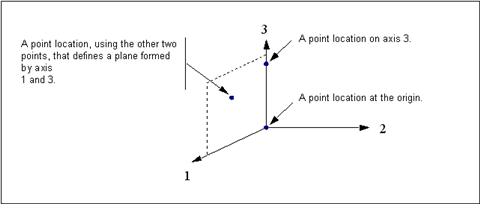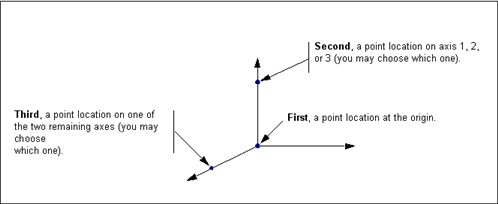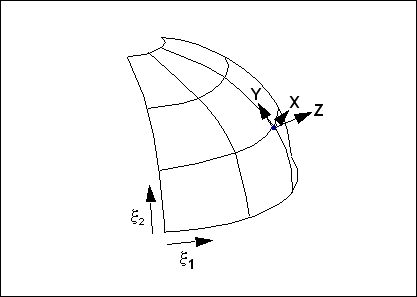XXXXXXXXXXXXXXXXXXXXXXXXXXXXXXXXXXXXXXXXXXXXXXXXXXXXXXXXXXXXXXXXXXXXXXXXXXXXXXXXXXXXXXXXXXXXXXXXXXXXXXXXXXXXXXXXXXXXXXXXXXXXXXXXXXXXXXXXXXXXXXXXXXXXXXXX''"> Overview of Create Methods For Coordinate Frames
There are six ways you can create a local rectangular, cylindrical or spherical coordinate frame in Patran. They are listed as separate methods under the Geometry Application’s Create action:
• 3Point
• Axis
• Euler
• Normal
• 2Vector
• View Vector
For more information on using the application forms for the Create methods, see
Creating Coordinate Frames.
You can also create coordinate frames using the Transform action’s Translate and Rotate methods. For more information, see
Transforming Coordinate Frames.
The following sections briefly discuss the Create methods for coordinate frames.
3 Point Method
Figure 3‑4 illustrates using the Create action’s 3 Point method for creating a coordinate frame by specifying three points:
Figure 3‑4 Coordinate Frame Creation Using the 3 Point Method
Axis Method
Figure 3‑5 illustrates using the Axis method to create a coordinate frame by specifying a point location at the origin, a point location on axis 1, 2, or 3, and a point location on one of the two remaining axes.
Figure 3‑5 Coordinate Frame Creation Using the Axis Method
Euler Method
The Euler Create action creates a new coordinate frame through three rotations from an existing coordinate frame. Specifically, the following steps are performed in the order shown:
1. Input the reference coordinate frame ID.
1. Enter the point location of the coordinate frame’s origin.
1. Enter the axis and rotation angle for Rotation 1.
1. Enter the axis and rotation angle for Rotation 2.
1. Enter the axis and rotation angle for Rotation 3.
The final orientation of the new coordinate frame depends on the order of rotations that are made.
Normal Method
Figure 3‑6 illustrates using the Normal method to create a coordinate frame, where its origin is at a point location on a surface. The positive axis 3 direction is normal to the surface by using right-hand rule and crossing the surface’s

parametric direction with the

direction. The axis 1 direction is along the surface’s

direction and the axis 2 direction is orthogonal to axis 1 and 3.
For more information on the definition of the parametric

and

axes, see
Parameterization.
Figure 3‑6 Coordinate Frame Creation Using the Normal Method



